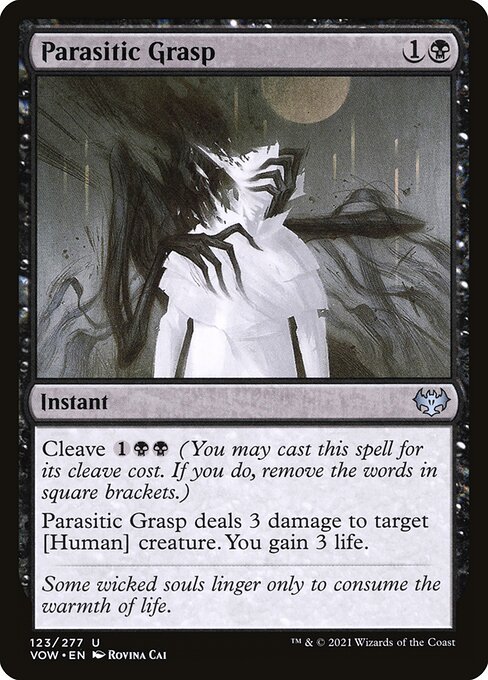
Image courtesy of Scryfall.com
Dark Reanimation Loops with Parasitic Grasp
Parasitic Grasp hails from Innistrad: Crimson Vow as a lean, black instant that wears a smile with a wicked edge. For only two mana, you can deal 3 damage to a Human creature and gain 3 life. If you opt into Cleave, paying {1}{B}{B} lets you remove the words in square brackets, expanding the target to any creature. That simple swap—Human specificity versus broad reach—turns Parasitic Grasp into a versatile tool for a graveyard-focused game plan 🧙♂️🔥. The art by Rovina Cai locks in the flavor: sinister resources slipping through the veil between life and death, exactly the mood you want when you’re building a dark reanimation engine. 💎
In decks built around graveyard recursion, Parasitic Grasp is more than a one-off removal spell. It doubles as a steadier of tempo and a source of life that keeps you in the game while you assemble your engine. The Cleave option is especially intriguing in midrange or control shells where you want to answer a broad set of threats without tipping your hand too early. Paying three mana to hit a cheap, non-Human target can be a calculated exchange in a longer game where you’re reusing spells from the graveyard to rebuild pressure. The flavor text—Some wicked souls linger only to consume the warmth of life—feels like a manifesto for players who thrive on attrition and the slow, creeping reclamation of what the graveyard owes them. ⚔️🎲
Why Parasitic Grasp fits a graveyard recursion strategy
Graveyard recursion decks in black-centric color schemes rely on spells that fetch value from the dead and put it back to work. Think reanimation spells like Reanimate or Exhume, or creatures and auras that enable repeated exploitation of the graveyard. Parasitic Grasp enters this circle as a flexible spell you can replay in crucial moments, to hold the line or close out a stalemate. Its Cleave variant makes it even more attractive when your plan calls for taking down a broad range of creatures—anything from token swarms to stubborn haymakers—while you maintain momentum with your graveyard engines. And yes, you can weave in Parasitic Grasp in a way that mirrors a dark looping dance: you remove a blocker, you heal, you extract a little more value from your graveyard, then you reset and go again. 🧙♂️
Consider the broader toolbox of a reanimator shell: Unearth, Reanimate, or Exhume can return your fastest threats from the graveyard, while Parasitic Grasp removes opposing foes and stabilizes your life total to weather a few more turns. The 3 life you gain each time you cast the base spell forms a tiny life reef, allowing you to weather aggressive starts while your recursion engines ramp up. The flavor of the card and the mechanical flavor together sing about an old, patient horror—one that patiently claws its way back into the light, again and again. 🔥💎
Practical gameplay tips for using Parasitic Grasp with graveyard recursion
- Play the base cost first when tempo is tight. Casting for {B} keeps you efficient on mana while still delivering a solid 3-damage punch and life gain. If you’re dealing with a key Human blocker, the base mode is a clean pick. 🧙♂️
- Leverage Cleave when you need flexibility. If a big non-Human threat is staring you down, the Cleave option expands your removal scope at a premium mana cost, which your graveyard plan can amortize as you replay more spells later. ⚔️
- Pair with reanimation spells to sustain pressure. Reanimate, Exhume, or Unearth can bring back your threats while Parasitic Grasp pings away at the board. Each recast tightens the loop and keeps you one step closer to stabilizing the game through attrition. 🎨
- Your life total matters, but not as a limiter. The life you gain acts as a buffer against aggro decks and can let you execute a longer plan without scrambling for air. Use that extra life to weave in more recursions and keep the engine churning. 💎
- Think beyond Humans when Cleave is paid. The Cleave text invites you to cast a broader protection or finish against a wider set of creatures, including planeswalkers that present threats through non-creature means. This flexibility is why Parasitic Grasp shines in post-board games or late-game setups. ⚔️
“Some wicked souls linger only to consume the warmth of life.” Parasitic Grasp embodies that whisper from the shadows—a reminder that in the graveyard, resilience is a special kind of power 🧙♂️.
Design-wise, Parasitic Grasp stands out for its clean, modular role in a multiverse of black-based recursion. It is a reminder that good removal doesn’t have to be flashy to be devastating; it just has to be timely and persistent. The set’s art direction and the Cleave mechanic give players a tactile sense of decision—do you lean into the precise, targeted strike or push for a broader, more dangerous sweep? The answer often depends on the state of the board and the rhythm of your graveyard engine. 🎲
As you sharpen your strategy, this card also serves as a nice bridge between classic reanimator builds and more contemporary “graveyard value” decks. It rewards you for budgeting mana wisely while maintaining pressure, and it gives you a way to stay relevant even when you’re not topdecking a game-winning threat. That’s the magic of Parasitic Grasp: a lean engine piece that rewards patient, creative play and a love for the old-school horror vibe that defines Innistrad’s best. 🧙♂️🔥
Neon Gaming Rectangular Mouse Pad 1/16 in thick non-slip
More from our network
- https://blog.digital-vault.xyz/blog/post/auratouched-mage-best-aura-combos-and-win-conditions/
- https://crypto-acolytes.xyz/blog/post/cross-validating-ground-based-observations-for-a-sagittarius-hot-blue-star/
- https://blog.digital-vault.xyz/blog/post/analyzing-player-engagement-across-mtg-archetypes-with-rite-of-the-dragoncaller/
- https://crypto-acolytes.xyz/blog/post/elite-four-strategies-for-pokemon-ruby-and-sapphire/
- https://crypto-acolytes.xyz/blog/post/how-ai-transforms-procedural-quests-in-games/